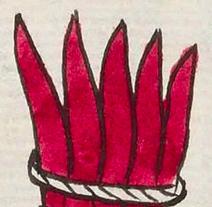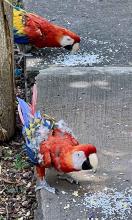cuezalin (Mdz6r)
This element has been carved from the compound sign for the place name, Cuezallan. This part consists of five standing scarlet macaw feathers, red with blue tips. The feathers are tied with a cord or rope.
Stephanie Wood
To the Nahuas, these feathers symbolized flames and fire. Thelma Sullivan, cited in our dictionary (in the reference elsewhere in this record), noted that Cuezaltzin (with the reverential ending) was one of the names of Xiuhtecutli, "God of Fire." Alfredo López Austin has also noted that Cuezalin was the name of a deity associated with death. See Los mitos del tlacuache (1996), p. 194. These particular macaw feathers do not have blue tips, which some in this collection do have.
Stephanie Wood
c. 1541, but by 1553 at the latest
Stephanie Wood
feathers, plumas, red and blue, bundled, flames, fire
These macaws were being fed in a little sanctuary for them in Parque Agua Azul in Guadalajara. Photo by S. Wood, 16 April 2025.

cuezal(in), tail or wing feathers of the scarlet macaw, https://nahuatl.wired-humanities.org/content/cuezalin
red macaw feathers
las plumas de guacamayo escarlata
Stephanie Wood
Codex Mendoza, folio 6 recto, https://digital.bodleian.ox.ac.uk/objects/2fea788e-2aa2-4f08-b6d9-648c00..., image 22, of 188.
The Bodleian Libraries, University of Oxford, hold the original manuscript, the MS. Arch. Selden. A. 1. This image is published here under the UK Creative Commons, “Attribution-NonCommercial-ShareAlike 3.0 License” (CC-BY-NC-SA 3.0).



